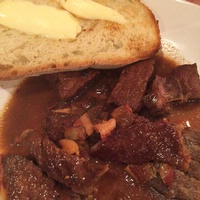WINE WITH…Beef Braised in Beer (Carbonade a la Flamande)
As Julia Child points out in the introduction to her recipe for Carbonnade in Mastering the Art of French Cooking, beef simmered in

beer rather than in the more common red wine braise has a very different taste profile. Mellow, nutty, and richly flavored, this is a dish with which everyone who likes to cook (and eat) should be familiar. And one of the great attributes of carbonnade is that, despite the beer, it’s a wonderful partner for red wine!
The standard cut of beef usually recommended for stews of this sort is chuck, boneless shank, or even flatiron or skirt steak. This time we used boneless short-ribs, which are tender and intensely flavored. We’ve never had a better carbonnade--even in France!
Beef Braised in Beer
Serves 4-6
Carbonnade is traditionally served with steamed or mashed potatoes, or with rice or noodles, but we served ours instead with thick slices of good toasted bread rubbed with garlic and lavishly buttered. (It was great for sopping up the juices!)
3-4 pounds beef such as chuck or boneless short-ribs
salt and pepper
4 slices bacon cut in 1 inch pieces
2-3 tablespoons butter
2 cups diced onion
3-4 cloves garlic, minced
2 tablespoons flour
½ cups beef or chicken stock
1 tablespoon brown sugar
1 tablespoon Dijon mustard
1 tablespoon wine or cider vinegar
1 bay leaf
1 teaspoon thyme
12 ounces dark or amber beer (preferably Belgian)
Cut the beef into 2-2 ½ inch pieces. Toss them with a little salt and pepper and let them sit for about 10 minutes. Meanwhile, cook the bacon in a Dutch oven or cast iron casserole until it just begins to brown. With a slotted spoon, remove it to a bowl, but do not wash out the pan. Add 1 tablespoon of the butter to the pan; when it turns foamy, add the onions and garlic and cook, stirring frequently, until the onions are very soft and just beginning to color. Remove them and reserve along with the bacon. Add another tablespoon of butter to the pan and whisk in the flour, adding more butter if the mixture looks too dry. When it is smooth and lump-free, whisk in the beef or chicken stock. Bring it to a simmer, then whisk in the brown sugar, mustard and vinegar. Add the bay leaf and thyme, then add the beef and pour in the beer. When the ingredients come to a boil, lower the heat, cover the pot and simmer for about 2 hours, or until the meat is very tender (you could also simmer it in the oven).
* * *
This is quite clearly a red wine dish. Deeply flavored, it pairs best with a wine that can match it step by step—or should we say, sip and bite. We thought that it might benefit from an earthy, rustic wine partner, but for the most part we preferred more overtly fruity reds. They provided a juicy complement and so enhanced the taste experience.